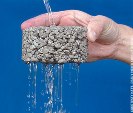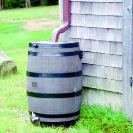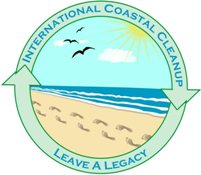 Many people don't realize they live in a watershed. Every drop of precipitation that falls in Monroe County will eventually end up in a nearby waterbody. Stormwater runoff occurs when water from rain or snowmelt flows over the ground. Impervious surfaces such as driveways, sidewalks, and streets prevent stormwater from naturally soaking into the ground. Along the way, this water picks up debris and other pollutants that can have an adverse effect on water quality. Most suburban storm sewer systems discharge directly into the waterbodies we use for swimming, fishing, and drinking water. The vast majority of sewers found in the City of Rochester, however, are combined sewer systems which convey stormwater and sewage to wastewater treatment facilities for cleaning.
Many people don't realize they live in a watershed. Every drop of precipitation that falls in Monroe County will eventually end up in a nearby waterbody. Stormwater runoff occurs when water from rain or snowmelt flows over the ground. Impervious surfaces such as driveways, sidewalks, and streets prevent stormwater from naturally soaking into the ground. Along the way, this water picks up debris and other pollutants that can have an adverse effect on water quality. Most suburban storm sewer systems discharge directly into the waterbodies we use for swimming, fishing, and drinking water. The vast majority of sewers found in the City of Rochester, however, are combined sewer systems which convey stormwater and sewage to wastewater treatment facilities for cleaning.
Polluted runoff is one of the nation's greatest threats to clean water.
Effects of Pollution:
- Sediment picked up by runoff can impact aquatic habitats.
- Bacteria can enter swimming areas, create health hazards, and lead to beach closures.
- Debris washed into waterbodies can harm aquatic life such as ducks, fish, turtles, and birds.
- Household hazardous wastes such as insecticides, pesticides, paint solvents, and auto fluids can also impact aquatic life. Animals and people can then become sick from eating contaminated fish or ingesting impacted water.
- Stormwater runoff can also impact drinking water sources. This can raise the cost of water treatment, and can affect human health.
Stormwater Solutions
 Permeable Pavement:
Permeable Pavement:
Traditional concrete and asphalt don't allow water to soak into the ground. Instead these surfaces rely on storm drains to divert unwanted water. Permeable pavement systems allow rain and snowmelt to soak through, decreasing stormwater runoff.
Native Plant Life:
Select native plants and grasses that are drought and pest resistant. Native plants require less water, fertilizer, and pesticides. Group plants according to their water needs.
- New York Native Flora (Monroe County Lookup)
 Rain Barrels:
Rain Barrels:
You can collect rainwater from rooftops in mosquito-proof containers. The water can be used later on lawn or garden areas.
 Vegetated Filter Strips:
Vegetated Filter Strips:
Filter strips are areas of native grass or plants created along roadways or streams. They trap the pollutants stormwater picks up as it flows across driveways and streets.
Rain Gardens and Grassy Swales:
Specially designed areas planted with native plants can provide natural places for rainwater to collect and soak into the ground. Rain from rooftop areas or paved areas can be diverted into these areas rather than into storm drains.
Homeowner Solutions
Many people are unaware of the indirect effects their actions can have on water quality in their area. Storm sewers located in your neighborhood may eventually discharge into a nearby water body.
Lawn Care
Excess fertilizers and pesticides applied to lawns and gardens wash off and pollute streams. In addition, yard clippings and leaves can wash into storm drains and contribute nutrients and organic matter that can be harmful to streams and waterbodies.
- Use pesticides and fertilizers only in the recommended amounts. Use organic mulch or safer pest control methods (IPM) whenever possible.
- Avoid applying fertilizers and pesticides if the forecast calls for rain; otherwise chemicals will likely be washed into your local stormwater system. Do not apply on paved areas (ie. sidewalk, street, driveway).
- Don't overwater your lawn. Water during the cooler times of the day, and don't let water run off into storm drains.
- Compost or mulch yard waste. Don't leave it in the street or sweep it into storm drains or streams.
- Cover piles of dirt or mulch being used in landscaping projects to prevent sediment from being carried away by runoff.
- Vegetate bare spots in your yard to prevent soil erosion.
Auto Care
Washing your car and degreasing auto parts at home can send detergents and other contaminants through the storm sewer system. Dumping automotive fluids into storm drains has the same result as dumping the materials directly into a body of water.
- Use a commercial car wash that treats or recycles its wastewater, or wash your car on your yard so the water infiltrates into the ground.
- Check your vehicle for leaks and spills. Make repairs as soon as possible.
- Clean up spilled fluids with an absorbent material like kitty litter or sand. Remember to properly dispose of the absorbent material.
- Dispose of used auto fluids and batteries at designated drop-off or recycling locations.
Septic Systems
Leaking and poorly maintained septic systems release nutrients and pathogens (bacteria and viruses) that can be picked up by stormwater and discharged into nearby waterbodies. Pathogens can cause public health problems and environmental converns.
- Inspect your septic system every 3 years and pump your tank as necessary (every 3 to 5 years).
- Never dispose of household hazardous waste in sinks or toilets.
Pet Waste
Pet waste can be a source of bacteria and excess nutrients in local waters.
- When walking your pet, remember to pick up the waste and dispose of it properly.
- Leaving pet waste on the ground increases public health risks by allowing harmful bacteria and nutrients to wash into the storm drain and eventually into local waterbodies.
Household Products
Recycle or properly dispose of household products that contain chemicals, such as insecticides, pesticides, paint, solvents, and used motor auto fluids.
- Don't pour them on the ground or into storm drains.
- Make an appointment with the Monroe County Household Hazardous Waste Facility.
Home Improvement
Home repair and construction creates large amounts of waste and debris which can find their way into storm drains.
- Before beginning an outdoor project, locate the nearest storm drains and protect them from debris and other materials.
- Sweep up and properly dispose of construction debris such as concrete and mortar.
- Use hazardous substances like paints, solvents, and cleaners in the smallest amounts possible, and follow the directions on the label. Clean up spills immediately, and dispose of the waste safely. Store substances properly to avoid leaks and spills.
- Purchase and use nontoxic, biodegradable, recycled, and recyclable products whenever possible.
- Clean paint brushes in a sink, not outdoors. Filter and reuse paint thinner when using oil-based paints. Donate unused paint to local organizations, or properly dispose of excess paints through a household hazardous waste collection program.
- Reduce the amount of unpaved area and increase the amount of vegetated area in your yard. Use native plants in your landscaping to reduce the need for watering during dry periods. Consider directing downspouts away from paved surfaces onto lawns and other measures to increase infiltration and reduce polluted runoff.
Commercial Solutions
Dirt, oil, and debris that collect in parking lots and paved areas can be washed into the storm sewer system and eventually enter local waterbodies.
- Sweep up litter and debris from sidewalks, driveways, and parking lots, especially around storm drains.
- Cover grease storage and dumpsters and keep them clean to avoid leaks.
- Report any chemical spills to the local hazardous waste cleanup team. They'll know the best way to keep spills from harming the environment.
Construction Solutions
Erosion controls that aren't maintained can cause excessive amounts of sediment and debris to be carried into the stormwater system. Construction vehicles can leak fuel, oil, and other harmful fluids that can be picked up by stormwater and deposited into local waterbodies.
- Divert stormwater away from disturbed or exposed areas of the construction site.
- Install silt fences, vehicle mud removal areas, vegetative cover, and other sediment and erosion controls and properly maintain them, especially after rainstorms.
- Prevent erosion by minimizing disturbed areas during construction projects, and seed and mulch bare areas as soon as possible.
Agricultural Solutions
Lack of vegetation can lead to erosion. Overgrazed pastures can also contribute to excessive amounts of sediment to local waterbodies. Excess fertilizers and pesticides can poison aquatic animals and lead to destructive algae blooms. Livestock in streams can contaminate waterways with bacteria, making them unsafe for human contact.
- Keep livestock away from streambanks and provide them a water source away from waterbodies.
- Store and apply manure away from waterbodies and in accordance with a nutrient management plan.
- Vegetate riparian areas along waterways.
- Rotate animal grazing to prevent soil erosion in fields.
- Apply fertilizers and pesticides according to label instructions to save money and minimize pollution.
 International Coastal Cleanup
International Coastal Cleanup
The International Coastal Clean Up is a global event with people from all over the world pitching-in to clean their shorelines. In doing so, they not only learn more about their local environment, but also about their relationship with it and with their neighbors as well.
Locally, the event began in 1993 at Durand Eastman Beach, through the ambitions and determination of a youthful group. Over the years, these young people have grown into young adults and the event has grown as well. What once was a small local event at one beach is now a countywide project.
In 2006, over 10,175 volunteers removed over 272,157 pounds of debris in New York state alone! For more information, visit the New York State Beach Cleanup website.
Links and Materials
- Rochester Pure Waters District
- Household Hazardous Waste Program
- H2O Hero Website
- EPA - Environmental Protection Agency
- New York Department of Environmental Conservation
- Ocean Conservancy
- Stormwater Coalition (Salt Lake County)
- American Littoral Society
- Greening Schools - Water Resources
- Center for Watershed Protection
- Low Impact Development Center
- National Association of Flood and Stormwater Management Agencies
- National Storm Water Best Management Practices (BMP) Database
- Rural Community Assistance Program (RCAP)
- National Association of Conservation Districts: Urban and Community Conservation
- Water Environment Federation













